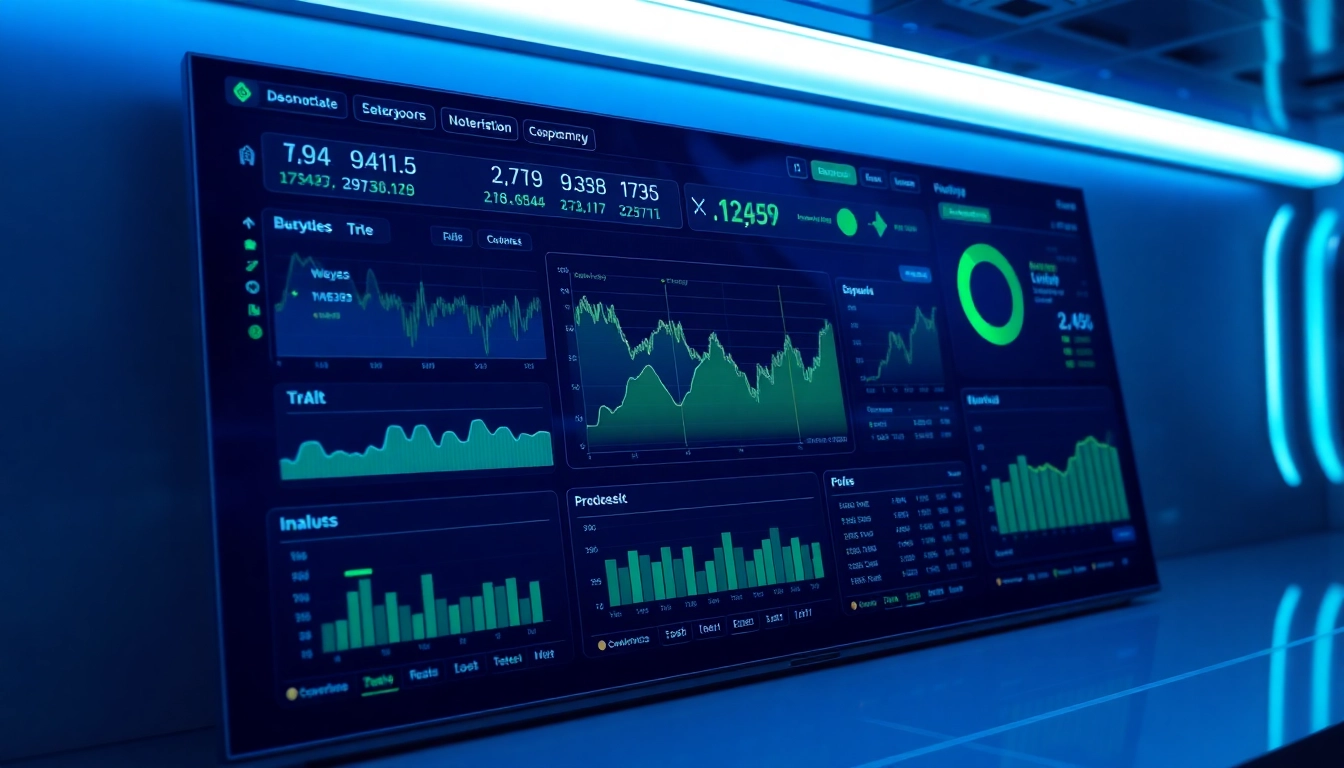Introduction to Trading View and Its Core Features
In the fast-paced world of financial markets, having access to advanced analytical tools and real-time data is essential for traders and investors. trading view has emerged as a leading platform, offering comprehensive charting, social networking features, and robust analytical functionalities. Its versatility caters to both seasoned traders and newcomers, providing an all-in-one environment to analyze multiple markets, share insights, and execute trades seamlessly. This article delves into the core features of Trading View, explores how it enhances market analysis, and guides you through maximizing its potential for successful trading outcomes.
What is Trading View and Why Use It?
Trading View is a sophisticated web-based platform that combines advanced charting tools with social trading features. It is designed to facilitate in-depth market analysis, fostering a vibrant community where traders can share ideas and strategies. Unlike traditional trading platforms that primarily focus on execution, Trading View emphasizes data visualization, statistical analysis, and collaborative insights. The platform covers an extensive range of markets, including stocks, forex, commodities, cryptocurrencies, and indices, making it a versatile tool for global trading.
The platform’s appeal lies in its user-friendly interface, customizable dashboards, and extensive library of indicators and drawing tools. Traders appreciate that they can develop and backtest trading strategies within the same environment, facilitating continuous learning and improvement. Moreover, Trading View’s cloud-based architecture ensures accessibility across devices, from desktops to mobile apps, enabling traders to stay connected and informed regardless of location.
Key Features and Tools for Traders
1. Advanced Charting Capabilities
Trading View offers ultra-responsive and intuitive charts equipped with a wide array of indicators, overlays, and drawing tools. Users can customize chart styles—candlestick, line, bar, or Heikin-Ashi—to suit their analytical preferences. The platform also supports multiple timeframes, from seconds to monthly views, allowing granular or broad market insights.
2. Extensive Library of Technical Indicators
With hundreds of built-in indicators such as Moving Averages, RSI, MACD, Bollinger Bands, and Fibonacci Retracements, traders can perform detailed technical analysis. Additionally, users can create custom scripts using Pine Script, Trading View’s proprietary coding language, to tailor indicators to specific strategies.
3. Social and Community Features
One of Trading View’s distinguishing aspects is its social network component. Traders can publish ideas, comment, and follow other analysts. This collaborative environment accelerates learning and provides diverse perspectives on market movements.
4. Alerts and Notifications
Real-time alerts are vital for timely decision-making. Trading View allows users to set alerts based on price levels, indicator conditions, or drawing tool criteria. Alerts can be received via email, SMS, or push notifications, ensuring traders never miss critical movements.
5. Multi-Market and Multi-Asset Analysis
The platform seamlessly integrates data across multiple markets, enabling traders to analyze equities, commodities, forex, and cryptocurrencies within singular or separate layouts. This multi-asset coverage supports diversified trading approaches and macroeconomic analysis.
How Trading View Enhances Market Analysis
Market analysis is the foundation of successful trading; Trading View elevates this process through real-time data streams, collaborative insights, and extensive analytical tools. Its cloud-based system provides access to up-to-the-minute charts and news feeds, reducing latency and ensuring data accuracy.
The platform’s social features convert individual analysis into community-driven insights. Traders can view, evaluate, and discuss charts shared by others, thereby broadening their understanding of market conditions. This democratization of information helps identify emerging trends faster and with higher confidence.
Moreover, Trading View supports complex technical analysis, backtesting, and strategy development. Traders can script custom indicators or use predefined templates, then evaluate performance over historical data to refine their approach. The combination of visual analysis and quantitative testing significantly improves decision-making quality.
Specialized features like heatmaps, economic calendars, and sentiment analysis further deepen the analytical process, helping traders pinpoint potential entry and exit points with greater precision.
Getting Started with Trading View
Creating an Account and Setting Up Your Profile
Getting started is straightforward. Visitors can sign up for free using an email address or social media accounts. After registration, traders can personalize their profiles, set preferences for notifications, and select markets of interest. Upgrading to premium plans unlocks additional features such as extended history, increased alerts, and faster data refresh rates.
Navigating the User Interface and Customizing Charts
The interface is designed for ease of use, featuring a top toolbar, chart area, and customizable sidebar. Users can add or remove indicators, adjust timeframes, and modify color schemes with simple drag-and-drop actions. Saving individual layouts allows quick access to frequently used setups, streamlining the analytical workflow.
Connecting Your Broker for Integrated Trading
For traders who wish to execute trades directly from Trading View, integration with supported brokers is crucial. The platform offers built-in options to connect accounts from partner brokers, enabling one-click trading, order management, and portfolio tracking. Setting up these connections involves authorizations and ensures that trading actions are synchronized in real-time.
Advanced Trading View Strategies
Utilizing Technical Indicators and Drawing Tools
Proficient traders leverage a combination of indicators and manual drawings to identify strong trading signals. For example, a trader might combine RSI divergence with trendlines to confirm reversals. Familiarity with indicators like Elliott Waves or Gann levels can add depth to analysis, supported by Trading View’s annotation features for clear visualization.
Implementing Trading Algorithms and Alerts
Automated trading strategies are possible through Pine Script, allowing traders to develop, backtest, and deploy custom algorithms. Alerts based on these scripts can notify traders of specific conditions, automating parts of the decision process and reducing emotional biases.
Analyzing Multiple Markets Simultaneously
Market correlations often influence trading decisions. Trading View’s multi-pane layouts enable simultaneous chart analysis across different assets or timeframes. This approach helps identify macro trends and divergence signals, essential for portfolio diversification and risk management.
Optimizing Trading View for Better Performance
Personalizing Your Watchlists and Layouts
Custom watchlists allow quick access to preferred assets, with real-time price updates. Organizing layouts by asset class, trading strategies, or timeframes saves time and enhances focus during analysis sessions. Cloud storage ensures that customizations are preserved across devices.
Leveraging Social Features for Insights
Engaging with the community by reviewing shared ideas and participating in discussions can expose traders to new techniques and market perspectives. Regular interaction enhances analytical skills and broadens network connections within the trading community.
Maintaining Data Security and Account Safety
Protecting sensitive data involves strong passwords, two-factor authentication, and cautious sharing of ideas. As Trading View stores personal settings and trade data, employing security best practices safeguards against unauthorized access and potential breaches.
Measuring Success and Improving Over Time
Interpreting Trading Data and Performance Metrics
Consistent review of trading logs, position sizes, and outcome metrics helps evaluate strategy effectiveness. Trading View’s built-in performance reports facilitate this review, enabling traders to identify strengths and areas for improvement.
Refining Strategies Based on Market Trends
Markets are dynamic; successful traders adapt by updating indicators, modifying trading parameters, and embracing new analysis techniques. Following trending ideas and statistical patterns on Trading View informs adjustments and innovation.
Scheduling Regular Reviews and Updates
Periodic analysis of trading performance and technology upgrades ensures that strategies remain relevant. Staying informed about platform updates, new tools, and market developments allows traders to leverage Trading View’s latest capabilities for competitive advantage.



